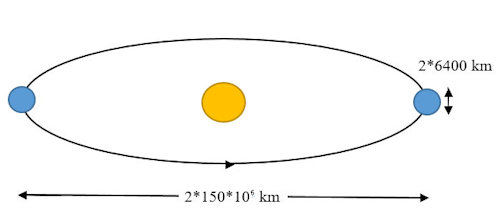
Electromagnetic waves transport energy through
space. In free space this energy is
transported by the wave with speed c. The magnitude of the
energy flux S is the amount of energy that crosses a unit area
perpendicular to the direction of propagation of the wave per unit time.
It is given by the energy density times the speed c.
The
energy per unit volume in the electric field is uE = ½ε0E2,
the energy per unit volume in the magnetic field is uB = B2/(2μ0),
and B = E/c.
We also have μ0ε0 = 1/c2.
We can therefore write
S = c(uE + uB) = ½(cε0E2
+ E2/(cμ0)) = ½(cε0E2
+ cε0E2) = cε0E2 =
EB/μ0.
The units of the energy flux S are J/(m2s) = W/m2.
EM waves transport energy and deliver it when absorbed.
The energy flux vector is
S. It has magnitude S and points in
the direction of propagation, i.e. in the direction of E ×
B.
It is called the
Poynting vector
and can also be written as
S = (E
× B)/μ0.
For a sinusoidal plane wave both E and B vary as a function of time as sin(kx - ωt + φ), and S varies as sin2(kx - ωt + φ).
To find the
magnitude of the average energy flux or intensity (I) of the wave we
average sin2(kx - ωt + φ) over each period, which yields ½. Then
I = <S> = ½(cε0Emax2).
Note: The energy transported by an electromagnetic wave is proportional to the square of the amplitude, Emax2, of the wave.
Remember: For all waves, the energy transported is proportional to the square of the amplitude.
How much electromagnetic energy per cubic meter is contained in sunlight if the intensity of the sunlight at the earth's surface under a fairly clear sky is 1000 W/m2?
Solution:
Assume the helium-neon lasers commonly used in student physics laboratories
have power outputs of 0.5 mW.
(a) If such a laser beam is projected onto a circular spot 1 mm in
radius, what is its intensity?
(b) Find the peak electric field strength.
(c) Find the peak magnetic field strength.
Solution:
The radiation field Erad produce by accelerating charges decreases as 1/r. Since the intensity is proportional to Erad2, the intensity of the radiation very far from a localized source therefore decreases as 1/r2, where r is the distance from the source. Energy is conserved. As the EM wave propagates away from the source, its spreads its energy over a spherical surface A = 4πr2, and therefore the energy per unit area decreases as 1/r2.
The sun emits electromagnetic radiation uniformly in all directions. Given the distance from the sun to the Earth of about ~150*106 km, and the mean radius of the Earth of about 6400 km, what fraction of the sun's radiation falls on the Earth?

Discuss this with your fellow students in the discussion forum!
Consider the geometry and energy conservation.
If the intensity of the sunlight at the earth's surface is 1000 W/m2, what is the rate P at which the sun radiates light energy in W?
Solution:
Summary: EM waves transport energy and deliver it when absorbed.
The average energy flux is I = <S> = ½(cε0Emax2).
Please watch
this
Youtube Video clip about using sunlight to melt rock.
Electromagnetic waves transport energy. EM wave also transport momentum. The magnitude of the momentum flux is <S>/c. It is the amount of momentum that crosses a unit area perpendicular to the direction of propagation of the wave per unit time. If an electromagnetic wave is absorbed, momentum conservation requires that the object acquires momentum. The object is therefore acted on by a force, F = ∆p /∆t. The radiation exerts radiation pressure P = F/A on the object. If the radiation is reflected instead of absorbed, then its momentum changes direction. The radiation pressure on an object that reflects the radiation is therefore twice the radiation pressure on an object that absorbs the radiation.
A plane electromagnetic wave of intensity 6 W/m2
strikes a small pocket mirror of area 40 cm2
held perpendicular to the approaching wave.
(a) What momentum does the wave transfer to the mirror each second?
(b) Find the force that the wave exerts on the mirror.
Solution:
Please watch this
Youtube
video clip. Optical tweezers are be used to trap, move and sort live
cells, organelles and large biomolecules. The cells interact with light
and change the momentum of a focused laser beam. This change in momentum
of the laser beam per unit time provides the tweezer force.
This tweezer force is small, but large enough to manipulate cells that are
floating in a liquid.